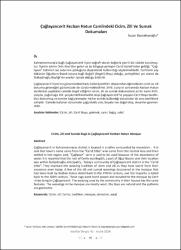Çağlayancerit Kezban Hatun Camiindeki Cicim, Zili Ve Sumak Dokumaları
Künye
BAYRAKTAROĞLU, Suzan. "Çağlayancerit Kezban Hatun Camiindeki Cicim, Zili Ve Sumak Dokumaları." Vakıflar Dergisi, 42 (2014): 99-122.Özet
Kahramanmaraş’a bağlı Çağlayancerit İlçesi coğrafi olarak dağlarla çevrili bir vâdide kurulmuştur.
İlçenin adının Orta Asya’dan gelen ve bu bölgeye yerleşen Cerid Aşireti’nden geldiği, “Çağlayan”
tabirinin ise sularının çokluğuna dayanılarak kullanıldığı söylenmektedir. Ceritlerin soy
kökünün Oğuzların Bozok koluna bağlı Beğdili (Begtili) Boyu olduğu, yerleştikleri yer olarak da
Dulkadiroğlu Beyliği’nin sınırları içinde olduğu bildirilir.
Çağlayancerit İlçesi’nin günümüzdeki halkı Cerid Aşireti’dir. Atalarından öğrendikleri cicim ve zili
dokuma geleneğini günümüzde de sürdürmektedirler. XVIII. yüzyılın sonlarında Kezban Hatun
tarafından yaptırılan camide tespit ettiğimiz cicim, zili ve sumak dokumaların az bir kısmı XVIII.
yüzyıla, çoğunluğu XIX. yüzyıla tarihlenmekte olup Çağlayancerit’te yaşayan Cerit Boyu tarafından
dokunmuş ve camiye bağışlanmıştır. Halkın evinde kullandığı dokumalar da aynı özelliklere
sahiptir. Camide bulunan dokumalar çoğunlukla yün, boyalar ise doğal olup, desenler geometriktir. Çağlayancerit in Kahramanmaras district is located in a valley surrounded by mountains . It is
said that town’s name came from the “Cerid tribe” who came from the Central Asia and then
settled in this region and, “Çağlayan” term is said to be used because of the abundance of
water. It is reported that the root of Cerits was Begdili, a part of Oğuz Bozoks and their location
was within Dulkadiroğlu principality.. Today’s community of Çağlayancerit district is the “Cerid
tribe”. They maintain the weaving tradition of cicim and zili as they have learnt from their
ancestors even today. A few of the zili and sumak weavings discovered in the mosque that
had been built by Kezban Hatun dated back to the XVIIIth century, and the majority is dated
back to the XIXth century. Those rugs were hand woven and donated to the mosque by Cerit
-tribe living in Çağlayancerit. The weaving used by the community in their houses has the same
features. The weavings in the mosque are mostly wool, the dyes are natural and the patterns
are geometric.
Koleksiyonlar
- Vakıflar Dergisi [825]



















